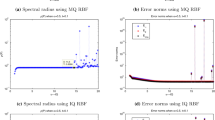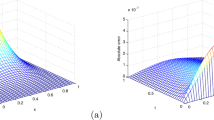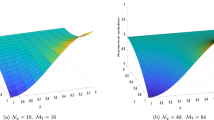Abstract
The impulsive differential equations are regarded as an optimal method to describe solute concentration fluctuation transport in unsteady flow field which are influenced by natural factors or human activities. The key difficulty of impulsive fractional-order system (IFS) in numerical discretization is that fractional-orders are different in different impulsive period. This paper proposes a double-scale-dependent mesh method considering the period memory, and makes a comparison with four collocation modes for the implict difference method. Furthermore, the stability and truncation error for graded meshes are estimated and analyzed. The analysis result reveals that the convergence rate mainly depends on the largest fractional order on the IFS. Numerical results show all graded meshes (producing the dense mesh at the early stage) provide better performance than uniform mesh. Meanwhile, the PDE cases show double-scale-dependent mesh is the most efficient numerical approximation method for the pulsation diffusion of contaminant in porous medium.




Similar content being viewed by others
References
Zhang Z, Mark B (1998) Characterizing three-dimensional hydraulic conductivity distributions using qualitative and quantitative geologic borehole data: application to a field site. Groundwater 36(4):671–678
Boisson A, Guihéneuf N, Perrin J, Bour O, Dewandel B, Dausse A, Viossanges M, Ahmed S, Maréchal J (2015) Determining the vertical evolution of hydrodynamic parameters in weathered and fractured south Indian crystalline-rock aquifers: insights from a study on an instrumented site. Hydrogeol J 23(4):757–773
Guo Z, Henri C, Fogg G, Zhang Y, Zheng C (2020) adaptive multirate mass transfer (aMMT) model: a new approach to upscale regional-scale transport under transient flow conditions. Water Resour Res. https://doi.org/10.1029/2019WR026000
Guo Z, Fogg G, Brusseau M, Jose L, LaBolle E (2019) Modeling groundwater contaminant transport in the presence of large heterogeneity: a case study comparing MT3D and Rwhet. Hydrogeol J 27(4):1363–1371
Chen K, Zhan H, Yang Q (2017) Fractional models simulating non-fickian behavior in four-stage single-well push-pull tests. Water Resour Res 53(11):9528–9545
Milman V, Myshkis A (1960) On the stability of motion in the presence of impulses. Sibirskii Matematicheskii Zhurnal 1(2):233–237
Lakshmikantham V, Bainov D, Simeonov P (1989) Theory of impulsive differential equations. World Scientific, Singapore
Baino D, Covachev V (1994) Differential equationswith a small perturbations. World Scientific, New Jersey, NJ, USA
Benchohra M, Henderson J, Ntonyas S (2006) Impulsive differential equations and inclusions. Hindawi Publishing Corporation, New York, NY, USA
Samoilenko M, Perestyuk A (1995) Impulsive differential equations. World Scientific, Singapore
Benchohra M, Berhoun F (2010) Impulsive fractional differential equations with variable times. Comput Math Appl 59(3):1245–1252
Wang J, Feckan M, Zhou Y (2016) A survey on impulsive fractional differential equations. Fract Calc Appl Anal 19:806–831
Feckan M, Zhou Y, Wang J (2012) On the concept and existence of solution for impulsive fractional differential equations. Commun Nonlinear Sci Numer Simul 17:3050–3060
Agarwal R, Hristova S, O’Regan D (2017) Non–instantaneous impulses in Caputo fractional differential equations. Fract Calc Appl Anal 20:595–622
Li H, Jiang Y, Wang Z, Hu C (2015) Global stability problem for feedback control systems of impulsive fractional differential equations on networks. Neurocomput 161:155–161
Wu G, Zeng D, Baleanu D (2019) Fractional impulsive differential equations: Exact solutions, integral equations and short memory case. Fract Calc Appl Anal 22(1):180–192
Zhang Y, Sun H, Stowell H, Zayernouri M, Hansen S (2017) A review of applications of fractional calculus in Earth system dynamics. Chaos Soliton Fract 102:29–46
Lubich C (1986) Discretized fractional calculus. SIAM J Math Anal 17(3):704–719
Lubich C (1988) Convolution quadrature and discretized operational calculus. II Numer Math 52(4):413–425
Podlubny I (1999) Fractional differential equations. Academic Press, New York
Podlubny I (2000) Matrix approach to discrete fractional calculus. Fract Calc Appl Anal 3(4):359–386
Diethelm K, Ford N (2002) Analysis of fractional differential equations. J Math Anal Appl 265(2):229–248
Diethelm K, Ford N, Freed A (2002) A predictor-corrector approach for the numerical solution of fractional differential equations. Nonlinear Dyn 29:3–22
Tadjeran C, Meerschaert M, Scheffler H (2006) A second-order accurate numerical approximation for the fractional diffusion equation. J Comput Phys 213(1):205–213
Tang S, Ying Y, Lian Y, Lin S, Yang Y, Wagner G, Liu W (2016) Differential operator multiplication method for fractional differential equations. Comput Mech 58:879–888
Ying Y, Lian Y, Tang S, Liu W (2017) High-order central difference scheme for Caputo fractional derivative. Comput Method Appl M 317:42–54
Chen M, Luan S, Lian Y (2021) Fractional SUPG finite element formulation for multi-dimensional fractional advection diffusion equations. Comput Mech 67:601–617
Lian Y, Ying Y, Tang S, Lin S, Wagner G, Liu W (2016) A Petrov-Galerkin finite element method for the fractional advection-diffusion equation. Comput Method Appl M 309:388–410
Luan S, Lian Y, Ying Y, Tang S, Wagner G, Liu W (2017) An enriched finite element method to fractional advection-diffusion equation. Comput Mech 60:181–201
Ying Y, Lian Y, Tang S, Liu W (2018) Enriched reproducing kernel particle method for fractional advection-diffusion equation. Acta Mech Sinica-Prc 34:515–527
Wang H, Zhang X (2015) A high-accuracy preserving spectral Galerkin method for the Dirichlet boundary-value problem of variable-coefficient conservative fractional diffusion equations. J Comput Phys 281:67–81
Wang H, Yang D, Zhu S (2017) Accuracy of finite element methods for boundary-value problems of steady-state fractional diffusion equations. J Sci Comput 70:429–449
Zhang Y, Sun Z, Liao H (2014) Finite difference methods for the time fractional diffusion equation on non-uniform meshes. J Comput Phys 265:195–210
Li C, Yi Q, Chen A (2016) Finite difference methods with non-uniform meshes for nonlinear fractional differential equations. J Comput Phys 316:614–631
Stynes M, O’Riordan E, Gracia J (2017) Error analysis of a finite difference method on graded meshes for a time-fractional diffusion equation. SIAM J Numer Anal 55(2):1057–1079
Jia J, Wang H (2019) A fast finite volume method for conservative space–time fractional diffusion equations discretized on space–time locally refined meshes. Comput Math Appl 78(5):1345–1356
Liu X, Sun HG, Zhang Y, Fu Z (2019) A scale-dependent finite difference approximation for time fractional differential equation. Comput Mech 63(3):429–442
Wu G, Deng Z, Baleanu D, Zeng D (2019) New variable-order fractional chaotic systems for fast image encryption. Chaos 29(8):083103
Nissan A, Dror I, Berkowitz B (2017) Time-dependent velocity-field controls on anomalous chemical transport in porous media. Water Resour Res 53:3760–3769
Acknowledgements
We thank Prof. Dumitru Baleanu for valuable discussion. This work (except that of Yong Zhang) is supported by the National Natural Science Foundation of China (Grant Nos. 11972148, 41831289 and 41931292), Natural Science Foundation of Jiangsu Province (Grant No. BK20190024). This paper does not necessarily reflect the view of the funding agency.
Author information
Authors and Affiliations
Corresponding author
Additional information
Publisher's Note
Springer Nature remains neutral with regard to jurisdictional claims in published maps and institutional affiliations.
Appendices
Appendix A
Lemma 2.1.
For 0 < \(\alpha \) k+1 < 1 and \(f_{k + 1} (s_{n} ) \in C^{2}\), \(s_{n} \in [t_{k} ,t_{k + 1} ]\backslash \left\{ {t_{{1}} , \ldots ,t_{m} } \right\}\), k = 0, 1, … m (when k = m and 0, \(t_{m + 1}^{ - } = t_{m + 1}^{ + }\) and \(t_{0}^{ - } = t_{0}^{ + }\). j is the j-th node of sn in [tk,tk+1]. when j = 0, sn = tk), it holds that
Proof
The discretization scheme of the integral shown in Eq. (18) can also be written as:
Then, we divide the scheme into two parts. First, utilizing integration by parts, it is easy to obtain:
Note that:
By combining Eqs. (20) and (21), we obtains:
Considering the linear interpolation, we can get
Then, we have
Using the Taylor series expansion, the error of the second term on the right-hand side of formula (19) is
By summing formulas (23) and (24), we complete the proof.\(\square\)
Appendix B
The inner products, L2 norm, H1 seminorm and H1 norm, are introduced:
Then the Green’s first formula can be written as:
where \(\Delta\) and \(\nabla\) represent the Laplace and gradient operator, respectively; and \(\overrightarrow {n}\) is the outer normal vector of the limited surface dS.
Lemma 2.2.
The difference scheme for the five collocation meshes for Eq. (11) is unconditionally stable to the initial condition \(u_{{t_{k} }} + R_{ku}^{{t_{k} }}\) u0 and the source part f:
Proof.
Multiplying both sides of Eq. (11) by \(- 2\Delta \left( {u(s_{n + 1} ) + R_{k} (s_{n + 1} )} \right)\) and then applying Green’s first formula, we get:
where j is the j-th node of sn within [tk, tk+1]. According to the monotonic increasing function \(\chi_{n + 1 - p}^{k} > 0\), we have
And we have \( \left\| {\nabla (u^{h} + R_{k}^{h} )} \right\|^{2} \le \left\| {\nabla \left( {u_{{t_{k} }} + R_{k}^{{}} } \right)} \right\|^{2} + \frac{{\Gamma (1 - \alpha_{k + 1} )}}{{2\left( {t_{k + 1} - t_{k} } \right)^{{ - \alpha_{k + 1} }} }}\mathop {\max }\limits_{1 \le h \le n + 1} \left\| {f_{h + 1}^{k + 1} } \right\|^{2} h = 0,1 \cdots j + 1\)
Then
According to Eq. (13) and \(R_{0}^{{t_{0} }} = 0\), the value of \(R_{k}^{n + 1}\) approaches zero with the increasing node number N by the recurrence relation.
The proof is completed.\(\square\)
Rights and permissions
About this article
Cite this article
Liu, X., Zhang, Y., Sun, H. et al. A fractional-order dependent collocation method with graded mesh for impulsive fractional-order system. Comput Mech 69, 113–131 (2022). https://doi.org/10.1007/s00466-021-02085-3
Received:
Accepted:
Published:
Issue Date:
DOI: https://doi.org/10.1007/s00466-021-02085-3




